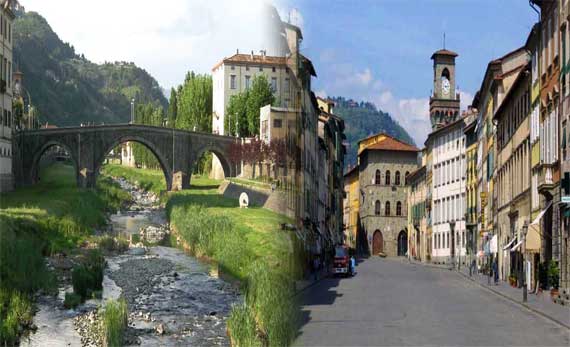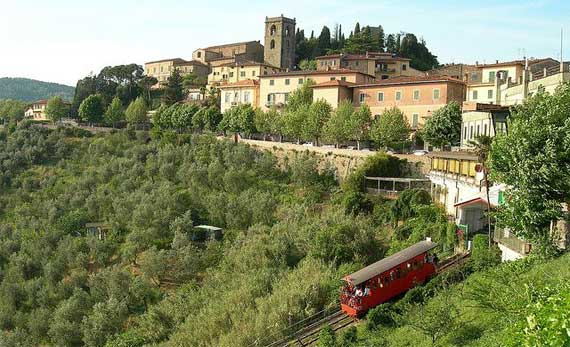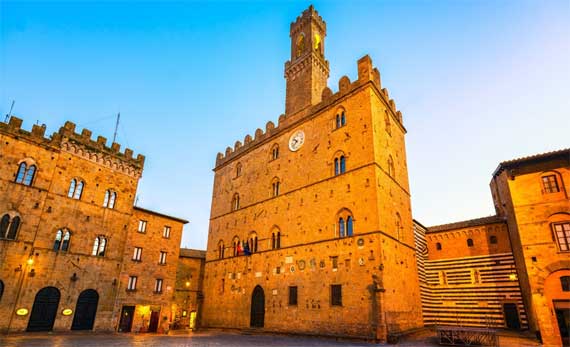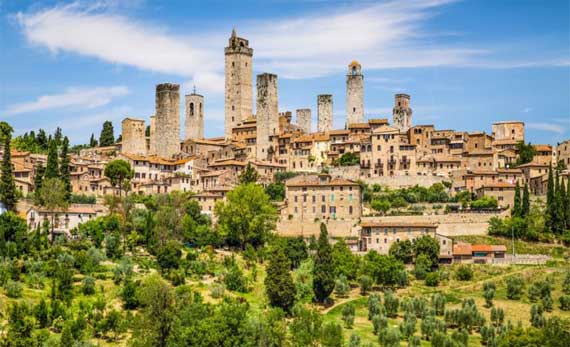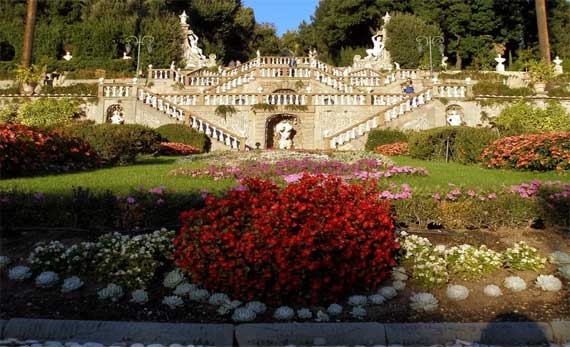
Collodi
Pinocchio's father ... is not Geppetto! It’s Carlo Lorenzini. famous for his pseudonym, Collodi precisely. It is in that he found his inspiration for the famous novel "The Adventures of Pinocchio", the most translated and widespread Italian book in the world.
In Pinocchio Park with games, workshops, interactive museums and virtual libraries is possible to experience the magical atmosphere of the fairy tale with Pinocchio, the Blue Fairy, the cat and the fox and all the characters of the fairy tale. The most courageous can also go into the mouth of the Great Pescecane.
Pescia: the city of flowers
Pescia is undoubtedly a very suitable destination for flower lovers, being absolutely among the most important Italian centers for floriculture.
Here you can visit the Bonsai Museum, opened since 1992, which offers a vast collection of wonderful specimens from all over the world. In the over 550 square meters exposure, you can admire centuries-old olive trees, groves of cypresses, exotic ficus, conifers and other essences, among the strangest and rarest existing.
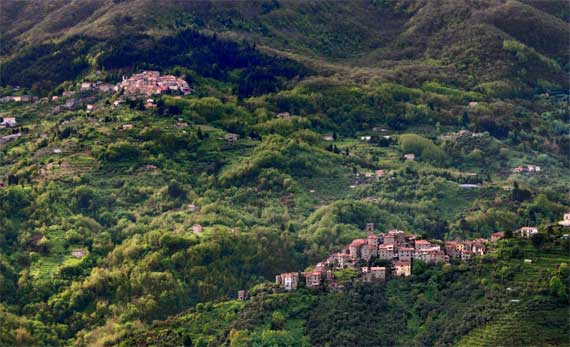
The Switzerland of Pescia
Jean Charles Sismondi, an historian, economist and writer from Ginevra gave the name to this green valley. He fell in love with these places that so much reminded him of his beloved homeland, for its colorful vegetation and its breathtaking views, which recall to the mind the magical alpine panoramas. The so-called 10 Castella are part of it, or 10 villages all built in sandstone: Pietrabuona, Fibbialla, Medicina, Aramo, Sorana, San Quirico, Vellano, Castelvecchio, Stiappa and Pontito.
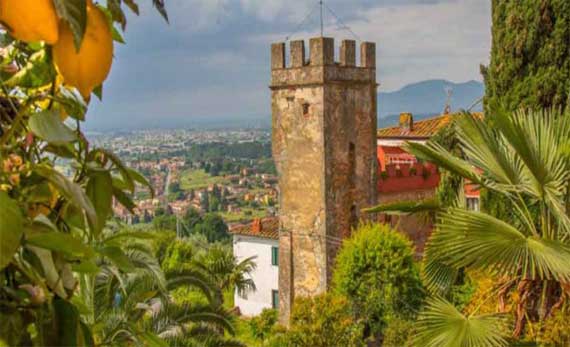
Buggiano Castello
Buggiano Castello is a medieval village of just one hundred and fifty inhabitants, whose walls hide a rich history and ancient charm. Cobbled and steep streets guide visitors in an atmosphere of times gone by. The pinnacle of medieval particularity is found in the beautiful Piazza Pretoria and in the parish churches of S. Nicolao and S. Lorenzo. Buggiano Castello is not only this: its natural peculiarity, in fact, are its splendid gardens where lush citrus trees grow, a rarity for these latitudes, whose growth is favored by the breath of particular hot currents.
Montecatini Alto
Montecatini Alto is one of the oldest medieval villages in the area. It is a pleasure to go around the walls, explore the artisan shops that animate the center, walk through squares, streets and alleys up to the main square. That’s a real gem, paved in stone and adorned with ancient coats of arms, full of places to taste a good wine and taste typical recipes of the Tuscan tradition. Montecatini Alto can be reached with a very special transport: the "Funicular" which looks like one of those trains of the western films that were pierced by the Indians.
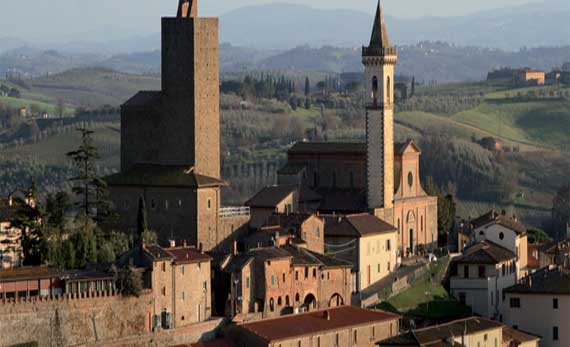
Vinci
Located on the slopes of a mountain and surrounded by vineyards and olive groves, the city of Vinci is a very nice medieval village. It’s internationally known for being the birthplace of the greatest genius of the Italian Renaissance: Leonardo da Vinci. Even today, the town is considered a sort of widespread museum dedicated to the artist. Here you can visit the church where he was baptized, the house where he was born,and the Leonardian Museum.
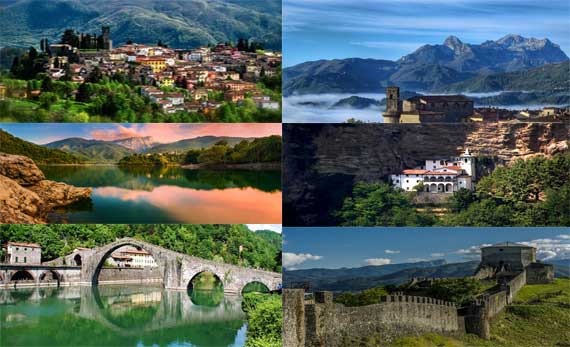
The Garfagnana's Villages
Garfagnana: literally Great Forest, because this valley appeared to its first visitors. Still today we are amazed by the luxuriant extension of its chestnut and beech woods. In this immense green mass, numerous villages appear perched on a hill or overhanging on vertiginous rocky walls. Each small and large center gives splendid panoramas, peculiarities and extraordinary cuisine. Here are some curiosities about the main towns, but they don’t complete these the suggestive scenarios offered by this splendid valley.
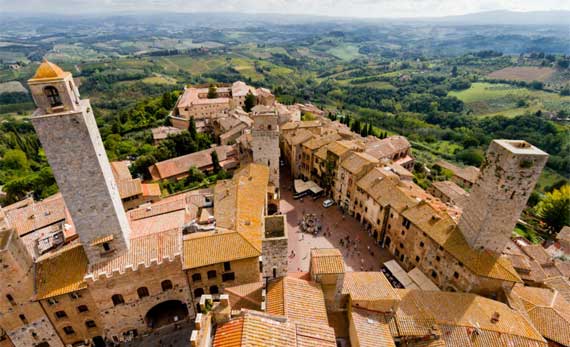
Certaldo
Medieval village among the most suggestive in Tuscany, Certaldo is famous for giving birth to Giovanni Boccaccio. Its historic center, also reachable by funicular, is famous because it develops along a single main road, without any large square. It gives a magical atmosphere having remained substantially the same as when the storyteller was born, lived and died there. Here is the house museum of Boccaccio, where he is presumed to have been born in 1313 and lived until his death.
Volterra
Entirely enclosed within the thirteenth-century walls, in Volterra coexist Etruscan, Roman, medieval and Renaissance imprints.Walking through the narrow streets of the village, you can feel the atmosphere of a past time. Here ancient crafts still survive, such as the processing of alabaster, flower at the buttonhole of Volterra craftsmanship. The heart of the city is Priori’s Square, overlooked by the most important buildings, including the Palazzo dei Priori, the oldest in Tuscany.
San Giminiano
San Gimignano is a splendid medieval village famous all over the world for its historical and artistic heritage and its architecture, in particular its towers. In the most prosperous period, the wealthy families of San Gimignano came to build 72 towers, as a symbol of their well-being and power. Today remain 14 of these, which contribute to making the town atmosphere even more fascinating.
In 1990 it was declared a World Heritage Site by Unesco.
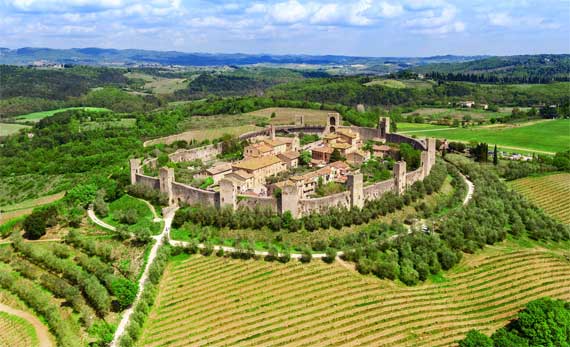
Monteriggioni
Monteriggioni is one of the most beautiful fortified villages in Italy. It is essential to climb the walls of the castle and walk along the stretches of the ancient walkways, from which you can enjoy wonderful views of the village and surrounding hills. Legend has it that during this walk it is possible to come across the traitor soul of the ghost of Monteriggioni, It was an inhabitant who allowed the siege of the hitherto impregnated village, during one of the many battles between Florence and Siena for his dominion.

Collodi
Pinocchio's father ... is not Geppetto! It’s Carlo Lorenzini. famous for his pseudonym, Collodi precisely. It is in that he found his inspiration for the famous novel "The Adventures of Pinocchio", the most translated and widespread Italian book in the world.
In Pinocchio Park with games, workshops, interactive museums and virtual libraries is possible to experience the magical atmosphere of the fairy tale with Pinocchio, the Blue Fairy, the cat and the fox and all the characters of the fairy tale. The most courageous can also go into the mouth of the Great Pescecane.
Pescia: the city of flowers
Pescia is undoubtedly a very suitable destination for flower lovers, being absolutely among the most important Italian centers for floriculture.
Here you can visit the Bonsai Museum, opened since 1992, which offers a vast collection of wonderful specimens from all over the world. In the over 550 square meters exposure, you can admire centuries-old olive trees, groves of cypresses, exotic ficus, conifers and other essences, among the strangest and rarest existing.

The Switzerland of Pescia
Jean Charles Sismondi, an historian, economist and writer from Ginevra gave the name to this green valley. He fell in love with these places that so much reminded him of his beloved homeland, for its colorful vegetation and its breathtaking views, which recall to the mind the magical alpine panoramas. The so-called 10 Castella are part of it, or 10 villages all built in sandstone: Pietrabuona, Fibbialla, Medicina, Aramo, Sorana, San Quirico, Vellano, Castelvecchio, Stiappa and Pontito.

Buggiano Castello
Buggiano Castello is a medieval village of just one hundred and fifty inhabitants, whose walls hide a rich history and ancient charm. Cobbled and steep streets guide visitors in an atmosphere of times gone by. The pinnacle of medieval particularity is found in the beautiful Piazza Pretoria and in the parish churches of S. Nicolao and S. Lorenzo. Buggiano Castello is not only this: its natural peculiarity, in fact, are its splendid gardens where lush citrus trees grow, a rarity for these latitudes, whose growth is favored by the breath of particular hot currents.
Montecatini Alto
Montecatini Alto is one of the oldest medieval villages in the area. It is a pleasure to go around the walls, explore the artisan shops that animate the center, walk through squares, streets and alleys up to the main square. That’s a real gem, paved in stone and adorned with ancient coats of arms, full of places to taste a good wine and taste typical recipes of the Tuscan tradition. Montecatini Alto can be reached with a very special transport: the "Funicular" which looks like one of those trains of the western films that were pierced by the Indians.

Vinci
Located on the slopes of a mountain and surrounded by vineyards and olive groves, the city of Vinci is a very nice medieval village. It’s internationally known for being the birthplace of the greatest genius of the Italian Renaissance: Leonardo da Vinci. Even today, the town is considered a sort of widespread museum dedicated to the artist. Here you can visit the church where he was baptized, the house where he was born,and the Leonardian Museum.

The Garfagnana's Villages
Garfagnana: literally Great Forest, because this valley appeared to its first visitors. Still today we are amazed by the luxuriant extension of its chestnut and beech woods. In this immense green mass, numerous villages appear perched on a hill or overhanging on vertiginous rocky walls. Each small and large center gives splendid panoramas, peculiarities and extraordinary cuisine. Here are some curiosities about the main towns, but they don’t complete these the suggestive scenarios offered by this splendid valley.

Certaldo
Medieval village among the most suggestive in Tuscany, Certaldo is famous for giving birth to Giovanni Boccaccio. Its historic center, also reachable by funicular, is famous because it develops along a single main road, without any large square. It gives a magical atmosphere having remained substantially the same as when the storyteller was born, lived and died there. Here is the house museum of Boccaccio, where he is presumed to have been born in 1313 and lived until his death.
Volterra
Entirely enclosed within the thirteenth-century walls, in Volterra coexist Etruscan, Roman, medieval and Renaissance imprints.Walking through the narrow streets of the village, you can feel the atmosphere of a past time. Here ancient crafts still survive, such as the processing of alabaster, flower at the buttonhole of Volterra craftsmanship. The heart of the city is Priori’s Square, overlooked by the most important buildings, including the Palazzo dei Priori, the oldest in Tuscany.
San Giminiano
San Gimignano is a splendid medieval village famous all over the world for its historical and artistic heritage and its architecture, in particular its towers. In the most prosperous period, the wealthy families of San Gimignano came to build 72 towers, as a symbol of their well-being and power. Today remain 14 of these, which contribute to making the town atmosphere even more fascinating.
In 1990 it was declared a World Heritage Site by Unesco.

Monteriggioni
Monteriggioni is one of the most beautiful fortified villages in Italy. It is essential to climb the walls of the castle and walk along the stretches of the ancient walkways, from which you can enjoy wonderful views of the village and surrounding hills. Legend has it that during this walk it is possible to come across the traitor soul of the ghost of Monteriggioni, It was an inhabitant who allowed the siege of the hitherto impregnated village, during one of the many battles between Florence and Siena for his dominion.

Collodi
Pinocchio's father ... is not Geppetto! It’s Carlo Lorenzini. famous for his pseudonym, Collodi precisely. It is in that he found his inspiration for the famous novel "The Adventures of Pinocchio", the most translated and widespread Italian book in the world.
In Pinocchio Park with games, workshops, interactive museums and virtual libraries is possible to experience the magical atmosphere of the fairy tale with Pinocchio, the Blue Fairy, the cat and the fox and all the characters of the fairy tale. The most courageous can also go into the mouth of the Great Pescecane.
Pescia: the city of flowers
Pescia is undoubtedly a very suitable destination for flower lovers, being absolutely among the most important Italian centers for floriculture.
Here you can visit the Bonsai Museum, opened since 1992, which offers a vast collection of wonderful specimens from all over the world. In the over 550 square meters exposure, you can admire centuries-old olive trees, groves of cypresses, exotic ficus, conifers and other essences, among the strangest and rarest existing.

The Switzerland of Pescia
Jean Charles Sismondi, an historian, economist and writer from Ginevra gave the name to this green valley. He fell in love with these places that so much reminded him of his beloved homeland, for its colorful vegetation and its breathtaking views, which recall to the mind the magical alpine panoramas. The so-called 10 Castella are part of it, or 10 villages all built in sandstone: Pietrabuona, Fibbialla, Medicina, Aramo, Sorana, San Quirico, Vellano, Castelvecchio, Stiappa and Pontito.

Buggiano Castello
Buggiano Castello is a medieval village of just one hundred and fifty inhabitants, whose walls hide a rich history and ancient charm. Cobbled and steep streets guide visitors in an atmosphere of times gone by. The pinnacle of medieval particularity is found in the beautiful Piazza Pretoria and in the parish churches of S. Nicolao and S. Lorenzo. Buggiano Castello is not only this: its natural peculiarity, in fact, are its splendid gardens where lush citrus trees grow, a rarity for these latitudes, whose growth is favored by the breath of particular hot currents.
Montecatini Alto
Montecatini Alto is one of the oldest medieval villages in the area. It is a pleasure to go around the walls, explore the artisan shops that animate the center, walk through squares, streets and alleys up to the main square. That’s a real gem, paved in stone and adorned with ancient coats of arms, full of places to taste a good wine and taste typical recipes of the Tuscan tradition. Montecatini Alto can be reached with a very special transport: the "Funicular" which looks like one of those trains of the western films that were pierced by the Indians.

Vinci
Located on the slopes of a mountain and surrounded by vineyards and olive groves, the city of Vinci is a very nice medieval village. It’s internationally known for being the birthplace of the greatest genius of the Italian Renaissance: Leonardo da Vinci. Even today, the town is considered a sort of widespread museum dedicated to the artist. Here you can visit the church where he was baptized, the house where he was born,and the Leonardian Museum.

The Garfagnana's Villages
Garfagnana: literally Great Forest, because this valley appeared to its first visitors. Still today we are amazed by the luxuriant extension of its chestnut and beech woods. In this immense green mass, numerous villages appear perched on a hill or overhanging on vertiginous rocky walls. Each small and large center gives splendid panoramas, peculiarities and extraordinary cuisine. Here are some curiosities about the main towns, but they don’t complete these the suggestive scenarios offered by this splendid valley.

Certaldo
Medieval village among the most suggestive in Tuscany, Certaldo is famous for giving birth to Giovanni Boccaccio. Its historic center, also reachable by funicular, is famous because it develops along a single main road, without any large square. It gives a magical atmosphere having remained substantially the same as when the storyteller was born, lived and died there. Here is the house museum of Boccaccio, where he is presumed to have been born in 1313 and lived until his death.
Volterra
Entirely enclosed within the thirteenth-century walls, in Volterra coexist Etruscan, Roman, medieval and Renaissance imprints.Walking through the narrow streets of the village, you can feel the atmosphere of a past time. Here ancient crafts still survive, such as the processing of alabaster, flower at the buttonhole of Volterra craftsmanship. The heart of the city is Priori’s Square, overlooked by the most important buildings, including the Palazzo dei Priori, the oldest in Tuscany.
San Giminiano
San Gimignano is a splendid medieval village famous all over the world for its historical and artistic heritage and its architecture, in particular its towers. In the most prosperous period, the wealthy families of San Gimignano came to build 72 towers, as a symbol of their well-being and power. Today remain 14 of these, which contribute to making the town atmosphere even more fascinating.
In 1990 it was declared a World Heritage Site by Unesco.

Monteriggioni
Monteriggioni is one of the most beautiful fortified villages in Italy. It is essential to climb the walls of the castle and walk along the stretches of the ancient walkways, from which you can enjoy wonderful views of the village and surrounding hills. Legend has it that during this walk it is possible to come across the traitor soul of the ghost of Monteriggioni, It was an inhabitant who allowed the siege of the hitherto impregnated village, during one of the many battles between Florence and Siena for his dominion.



